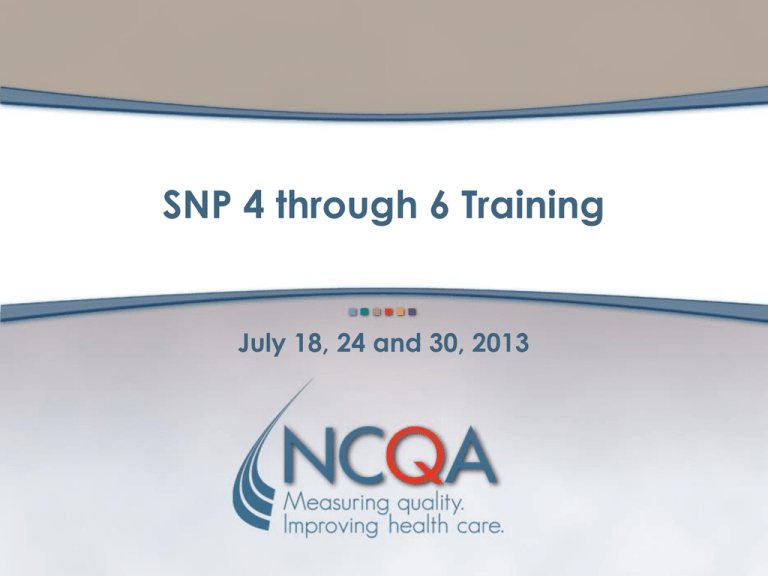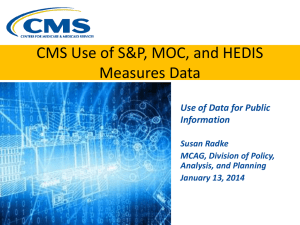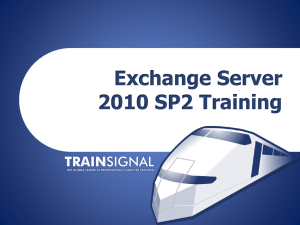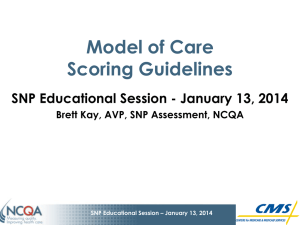SNP 4 Element A
advertisement

SNP 4 through 6 Training July 18, 24 and 30, 2013 Objectives of SNP Training • Review NCQA’s year-to-year approach to the project and reporting requirements for SNPs • Describe the changes in the S&P measures for the 2013 SNP Assessment • Explain how NCQA assesses plans’ performance with individual elements in the S&P Measures SNP 4 through 6 Training 2 Objectives of SNP Assessment Program • Develop a robust and comprehensive assessment strategy • Evaluate the quality of care SNPs provide • Evaluate how SNPs address the special needs of their beneficiaries • Provide data to CMS to allow plan-plan and year-year comparisons SNP 4 through 6 Training 3 SNP Assessment: How did we get here? • Existing contract with CMS to develop measures focusing on vulnerable elderly • Revised contract to address SNP assessment 2008 - rapid turnaround, adapted existing NCQA measures and processes from Accreditation programs 2009 - focused on SNP-specific measures 2010 - refined existing measures 2011 - clarified requirements in SNP 1 thru 6 2012 - refined measures and documentation requirements; focus on implementing interventions SNP 4 through 6 Training 4 Who Reports • HEDIS measures – All SNP plan benefit packages with 30 or more members as of February 2012 Comprehensive Report (CMS website) • S&P measures – All SNP plan benefit packages – Plans with zero enrollment as of April 2013 Comprehensive Report are exempt for certain elements SNP 4 through 6 Training 5 SNP Reporting • Returning SNPs— all SNPs that were operational as of January 1, 2012 AND renewed for 2013 AND have previously submitted. – SNP 1 A-G, SNP 2A-C, SNP 3-6 • New SNPs — all SNPs operational as of January 1, 2012 AND renewed for 2013 AND are reporting for the first time. – SNP 1 A-D, SNP 2A-C, SNP 4-6 SNP 4 through 6 Training 6 Project Time Line – 2013-2014 • June 2013 through September 2013- Training for SNPs • June & July 2013 - Release S&P Measures in hardcopy and ISS Data Collection Tool • October 15, 2013 - S&P Measure submissions due to NCQA • October 15, 2013 to April 30, 2014 – S&P reviews conducted by NCQA and surveyors • June 2014 - NCQA delivers SNP Assessment Report to CMS SNP 4 through 6 Training 7 Structure and Process Measures SNP 4: Care Transitions SNP 4: Care Transitions • Focuses on coordination of information related to transitions of care from one setting to another (e.g., hospital to home) • Identify “at-risk” members and take actions to prevent or reduce unplanned transitions – Coordinate services – Educate members SNP 4 through 6 Training 10 What’s Changed? • No major content, documentation or scoring changes • Element E—Added a new factor that requires plans to take actions or interventions related to the opportunities identified in factor 2. • Element E—clarified that plans may use their existing CMS QIP related to reducing hospital admissions to satisfy factor 3 requirements SNP 4 through 6 Training 11 SNP 4 Element A: Managing Transitions • Managing & coordinating planned/unplanned transitions from one care setting to another – Factor 1 focuses on planned transitions to and from a hospital • Requires SNP to show it is aware that a transition is about to take place—before it happens and provide support throughout the transition process, not just after discharge • A preauthorization policy included in documentation must show how it triggers clinical action. Cannot solely pertain to a coverage or payment decision. SNP 4 through 6 Training 12 SNP 4 Element A • Factor 2 specifies requirements for planned and unplanned transitions to and from a hospital • Sending setting must share care plan with receiving setting within 1 business day of transition notification – Care plan consists of patient info that facilitates communication, collaboration and continuity of care across settings – Org determines what info care plan includes – Must specify practitioner to receive care plan for planned transitions to hospital—must show evidence SNP shared care plan with practitioner w/in specified timeframe SNP 4 through 6 Training 13 SNP 4 Element A • Factor 3: Notifying member’s usual practitioner of transition – planned and unplanned transitions to and from all care settings – must specify a timeframe for completion of transition activities, e.g., • 24-48 hours prior to member movement to receiving setting • within 1 business day of member’s discharge • at least 2 calendar days before the scheduled procedure SNP 4 through 6 Training 14 SNP 4 Element B Supporting Members Through Transitions • Communications with members/ caregivers within specified timeframes regarding: – the transition process and what to expect – changes in health status and their care plan – who will support them through the process • Factors 1 thru 3 pertain to planned and unplanned transitions to and from all care settings SNP 4 through 6 Training 15 SNP 4 Element B • A SNP’s documented process for factors 1 thru 3 must specify a timeframe for completion of required transition activities – The following do not qualify as timeframes •during the encounter …. •upon identification of transition needs …. •regular contact and review …. •on an ongoing basis …. •during discharge …. SNP 4 through 6 Training 16 SNP 4 Element C • SNPs must include all activities from Elements A & B in the analysis: – assess the frequency a SNP performs the following functions: • Identify planned transitions • Share care plan across settings w/in 1 bus. day • Notify usual practitioner • Communicate w/ member about transition process • Communicate w/member about care plan • Communicate w/member about point of contact SNP 4 through 6 Training 17 SNP 4 Element C • The intent of the aggregate analysis for this element is for plans to assess how well they are managing transition activities. • Factors 1 and 3 need to show: – data collected; – a quantitative and qualitative analysis; and – the opportunities for improvement • Factors 2 and 4 must describe: – the universe of members in the sample – sampling methodology – how the SNP drew at least 3 months of data SNP 4 through 6 Training 18 SNP 4 Element C What is an Analysis? • An evaluation of aggregate performance that includes: – quantitative data – number of transitions in the denominator for a factor and the number of transitions where the SNP performed the activity specified by the factor within any pertinent timeframes – qualitative data – notations on results, trends, anomalies, assessment of causes/reasons for findings » identification of opportunities and recommendations for further action SNP 4 through 6 Training 19 SNP 4 Element D Identifying Unplanned Transitions • A SNP must show that it: – has a documented process and reviews reports of hospital admissions within 1 business day of the admission • Must show at least 3 admissions – reviews reports of long-term care facility admissions within 1 business day of the admission • Must show at least 3 admissions SNP 4 through 6 Training 20 SNP 4 Element E • Focus of element is on minimizing unplanned transitions and keeping patients in least restrictive setting • Factor 1 requires an analysis of patient-specific data to identify those at risk − E.g., claims, UM or provider reports, predictive modeling SNP 4 through 6 Training 21 SNP 4 Element E • A SNP’s documentation for factor 1 needs to show: – data collected—must monitor all members – members targeted – areas where it acts to minimize the risk of unplanned transitions and keep members in the least restrictive setting SNP 4 through 6 Training 22 SNP 4 Element E Factor 2 requires SNPs to analyze data and identify areas where avoidable, unplanned transitions can be reduced • Analyze member admissions to all hospitals and ED visits – Population focus (aggregate data) – Actual analysis to identify areas for improvement SNP 4 through 6 Training 23 SNP 4 Element E • SNP’s documentation for factor 2 must show: 1) data collected 2) quantitative and qualitative analysis 3) opportunities for improvement. • SNP must include in-network and out of network facilities and EDs in this analysis for factor 2. If it only includes in-network facilities, it does not receive full credit for this factor (cannot score >50%). SNP 4 through 6 Training 24 SNP 4 Element E • New clarification! SNP must provide evidence of 1 analysis performed after 10/15/12 – Data collected must be dated after 10/15/12 • Analyses must be SNP-specific; organizations that perform an aggregate analysis of multiple benefit plans must break out the data for each individual plan SNP 4 through 6 Training 25 SNP 4: Element E • New for 2013: Factor 3—implementing interventions • The SNP must implement at least one intervention from the opportunities identified in factor 2 during the look-back period. – Do not have to show improvement or effectiveness of the intervention – SNPs can use their existing CMS QIP related to reducing hospital readmissions SNP 4 through 6 Training 26 SNP 4 Element F Reducing Transitions Factors 1 and 2 require a SNP’s documentation to show that it: • Coordinates services for at-risk members • Educates these members or their caregivers on how to prevent unplanned transitions Actions must relate to findings from monthly analyses in SNP 4:E, factor 1 SNP 4 through 6 Training 27 SNP 4 Element F • Factor 1—Care Coordination may be done through Case Mgmt or other programs; SNP must maintain special procedures if all members are not in CM • Factor 2—Educational opportunities must be related to specific, targeted populations, not just general health education SNP 4 through 6 Training 28 SNP 4 through 6 Training 29 SNP 5: Institutional SNP Relationship with Facility SNP 5 Element A Monitoring Members’ Health Status • Institutional SNPs only – Focus is on communications with facilities to monitor member needs and services provided – Facilities include contracted nursing facilities and assisted living facilities • The SNP must show that it monitors information on members’ health status at least monthly – Communication should include information that may indicate a change in health status or no change SNP 4 through 6 Training 31 SNP 5 Element A • Scoring •100% or full credit – Institutional SNPs who monitor at least monthly •50% or partial credit – Institutional SNPs who monitor at least quarterly •0% or no credit – Institutional SNPs who monitor less often than quarterly SNP 4 through 6 Training 32 SNP 5 Element A • Monitoring methods a SNP can use: – data derived from MDS or other reports on member health status it requires from the institutional facility – reports from its staff who visit members in facilities – data on members’ health status it collects through care management if collected on a monthly basis • Status reports may include: – – – – Functional status assessments Medication regimen Self-reported health status Reports on falls, socialization and depression SNP 4 through 6 Training 33 SNP 5 Element A • Documentation – a SNP must provide a documented process and one additional data source or it does not receive full credit for this element • Element is NA for: – An Institutional SNP that shows it does not have contracts with nursing facilities or assisted living facilities all members reside in the community • Dual Eligible and Chronic Care SNPs are exempt – Score all elements in this measure “NA” SNP 4 through 6 Training 34 Polling Question • True or False An Institutional SNP that only has contracts with and members residing in assisted living facilities is exempt from reporting SNP 5 Element A SNP 4 through 6 Training 35 SNP 5 Element B Monitoring Changes in Members’ Health Status • Organization monitors and responds to triggering events and changes by: 1. 2. 3. 4. Setting parameters for the types of changes and triggering events contracted facilities must report within 48 hours, 3 calendar days and 4 to 7 calendar days Identifying who will act on that information and should be contacted Identifying how the member’s care will be coordinated with appropriate clinicians or the clinical care plan Identifying one monitoring or data collection method it uses to assess changes in all members’ health status SNP 4 through 6 Training 36 Factor 1 Details • An organization must submit evidence that shows it has identified specific conditions or early warning signs and symptoms that facilities must report within a minimum of: 48 hours 3 calendar days 4-7 days • The SNP must submit a documented process and reports or materials showing how and when facility staff must report a list of triggers such as: changes in vital signs changes in the member’s behavior changes in their functional status complaints of pain SNP 4 through 6 Training 37 SNP 5 Element B • Explanation of scoring •100% or full credit – The organization meets all 4 factors •50% or partial credit – The organization meets 3 factors including factors 1 through 3 (critical factors) •0% or no credit – The organization meets 0-2 factors or does not meet factors 1, 2 or 3 SNP 4 through 6 Training 38 SNP 5 Element B • The SNP must demonstrate it monitors members through one of the following methods: – Reports from facilities to the organization such as Minimum Data Set (MDS) – Reports from organization staff who visit the members – Oversight of facility monitoring and reporting changes to treating practitioners rather than to the organization – A combination of the processes above SNP 4 through 6 Training 39 SNP 5 Element C Maintaining Members’ Health Status • Organizations use the information from SNP 5 Elements A&B to identify at-risk members and work with facilities/practitioners to arrange for necessary care and adjust care plans as needed to prevent declines in member health status • Scoring is 100% or 0% (all or nothing element) SNP 4 through 6 Training 40 SNP 5 Element C Methods of providing care: • SNPs may have differing models of relationships with facilities to address these monitoring functions – Facility oversight: relies on facilities to modify/carry out care plans – Staff practitioners: SNP staff practitioners visit facilities and order care plan modifications – Other models of care: SNPs may use a combination of above models or different one SNP 4 through 6 Training 41 SNP 5 Element C Documentation • A SNP must submit: – Documented Processes; AND • Policies describing increases in frequency of visits to member by the organization’s nurse managers to assess, revise the care plan and monitor his or her condition after a health status decline and resulting inpatient stay – Reports • Screenshots from the organization’s care management system documenting monitoring visits, assessments and care plan changes the nurse managers discussed with the member’s treating practitioner and notes confirming the practitioner’s agreement SNP 4 through 6 Training 42 SNP 4 through 6 Training 43 SNP 6: Coordination of Medicare and Medicaid Coverage What’s Changed? No major changes in 2013!!! SNP 4 through 6 Training 45 SNP 6 Element A Not Applicable for C-SNPs & I-SNPs Coordination of Benefits for Dual-Eligible Members Dual-eligible SNPs coordinate Medicare & Medicaid benefits/services for their members by: • Giving members access to staff knowledgeable about both programs • Providing clear explanations of rights to pursue grievances/appeals under both programs • Providing clear explanations of benefits and any communications they receive re: claims, cost sharing SNP 4 through 6 Training 46 SNP 6 Element A • Documentation - SNPs must provide reports and may include documented processes or materials to supplement them – Reports: • Evidence of Coverage (EOC) documentation – Materials: • Scripts or guidelines for staff who help members with eligibility, benefits and claims for both Medicare and Medicaid (Factors 1 & 2) • Job descriptions for staff who help members with eligibility, benefits and claims for both Medicare and Medicaid • SNP 4 through 6 Training 47 SNP 6 Element A • For all factors — SNP must provide information to members for Medicare AND Medicaid. The SNP cannot receive credit for any factor where it provides the required information for only Medicare without a report demonstrating resources for information on Medicaid. SNP 4 through 6 Training 48 SNP 6 Element A • Documentation must show: – SNP’s materials cover the details of members’ specific benefit plans – It gives members information on staff who can answer questions regarding both programs in lieu of written documents – SNP staff can answer questions about Medicare benefits and the state’s payment cost-sharing as well as Medicaid eligibility and cost-sharing for services where the member is liable. SNP 4 through 6 Training 49 SNP 6 Element B Not Applicable for C-SNPs & I-SNPs Administrative Coordination of Dual-Eligible Benefit Packages A dual-eligible SNP coordinates Medicare and Medicaid benefits for its members by: •Identifying changes in members’ Medicaid eligibility •Coordinating adjudication of Medicare/ Medicaid claims for which it is contractually responsible SNP 4 through 6 Training 50 SNP 6 Element B • SNPs must demonstrate that they monitor instances where members are losing Medicaid eligibility and regaining Medicaid eligibility to receive credit for factor 1. • Factor 2 is scored “Yes” if a SNP that is not contractually responsible for the adjudication of Medicaid claims submits documentation showing that it helps members understand the state’s adjudication of claims submitted by providers. SNP 4 through 6 Training 51 SNP 6 Element B Documentation • SNPs must provide (1) documented processes and (2) reports OR materials – Documented processes: • Procedures used to determine changes in Medicaid eligibility • Procedures used to coordinate adjudication of Medicare and Medicaid claims – Materials: • Scripts or guidelines for staff who help members eligibility, benefits, and claims for both programs – Reports: • Redacted reports on Medicaid eligibility used by organization SNP 4 through 6 Training 52 SNP 6 Element C Not Applicable for D-SNPs Administrative Coordination for Chronic and Institutional Benefit Packages • SNP shows it coordinates Medicare/Medicaid benefits for C-SNP& I-SNP members by: – Using a process to identify changes in members’ Medicaid eligibility – Informing members about maintaining Medicaid eligibility – Giving members information about benefits they are eligible to receive under both programs – Giving members access to staff who can advise them on using both programs SNP 4 through 6 Training 53 SNP 6 Element C • Factors 1, 3 and 4—SNP must supply documentation that shows it provides information to members for Medicare AND Medicaid. The SNP cannot receive credit for factors 1, 3 and 4 if it provides the required information only for Medicare. SNP 4 through 6 Training 54 SNP 6 Element C • To receive credit for factor 2: – I-SNPs’ documentation must address changes where members gain Medicaid eligibility; – C-SNPs’ documentation must show that they monitor instances where members are gaining and losing Medicaid eligibility. SNP 4 through 6 Training 55 SNP 6 Element C • SNP’s materials cover the details of members’ specific benefit plans • SNP’s staff can answer questions about Medicare benefits and the state’s payment cost-sharing as well as Medicaid eligibility and cost-sharing for services where the member is liable. • Documentation - SNPs must provide: – Documented processes • Procedures used to verify changes in Medicaid eligibility – Reports or Materials • Sample benefit summaries provided to members SNP 4 through 6 Training 56 SNP 6 Element C • C-SNPs and I-SNPs are exempt from this element if less than 5% of the members in their SNP population are dual eligibles as of the start of the look-back period (April 15, 2013). SNP 4 through 6 Training 57 SNP 6 Element D Applicable for all SNPs* Service Coordination • Organization coordinates delivery of services covered by Medicare/Medicaid through the following: – Helping members access network providers that participate in both programs or accept Medicaid patients – Educating providers about coordinating benefits for which members are eligible and about members’ special needs – Helping members obtain services funded by either program when needed * C-SNPs and I-SNPs are exempt from this element if less than 5% of the members in their SNP population are dual SNP 4 through 6 Training 58 SNP 6 Element D • Helping dual-eligible members obtain services covered by Medicare & Medicaid – The SNP must require that its network physicians do not bill dual-eligible members for more than the copayment amount which the state pays for individuals in that category of Medicaid eligibility. SNP 4 through 6 Training 59 SNP 6 Element D For factor 1 • SNP must publish a directory that shows: – providers that participate in both programs or – providers that accept Medicare for services covered by Medicare and – providers that accept Medicaid for dualeligible members SNP 4 through 6 Training 60 SNP 6 Element D Factor 2 requires SNPs to educate network practitioners and providers about their role coordinating Medicare/Medicaid benefits and members’ special needs. A SNP can: – Alert their providers to the range of benefits or services for which members are eligible, as well as responsibility for cost-sharing, if any, and their right to reimbursement – Inform providers who is responsible for coordinating services for both programs SNP 4 through 6 Training 61 SNP 6 Element D Factor 3 requires SNPs to help members obtain services funded by either program when assistance is needed. The SNP can: – Show processes and materials that describe how it helps members obtain services covered by Medicare and Medicaid – Submit a policy and materials it gives to members that details how they can obtain non-emergency transportation services for appointments and medical procedures. SNP 4 through 6 Training 62 SNP 6 Element D • Documentation - SNPs must provide: – Documented processes; AND •Policies and procedures for arranging services for members – Reports or Materials •Reports detailing how members were assisted in obtaining services from Medicaid when needed. •Materials such as the provider directory or provider manuals. SNP 4 through 6 Training 63 SNP 6 Element E Applicable for all SNPs* Network Adequacy Assessment • Organization assesses the adequacy of the network for member access to practitioners and provider by: - Establishing standards of the number and geographic distribution of each type of practitioner and provider - Conducting an annual analysis of performance against said standards * Element is NA for C-SNPs and I-SNPs w/less than 5% dual eligible members and D-SNPs with no enrollment at the start of the look-back period (April 15, 2013). SNP 4 through 6 Training 64 SNP 6 Element E • The SNP must provide documented process for factors 1 and 2 and reports for factors 3 and 4. • The SNP’s documentation must include the geographic and numeric standards for practitioners and providers and a description of its methodology used to perform the analysis. SNP 4 through 6 Training 65 SNP 6 Element E • The SNP’s analysis must include a network access indicator (ratio of member to practitioner availability based a number of miles/minutes). A plan that uses: 1) Access data (appointment availability) 2) Data on members’ cultural or linguistic needs or 3) Satisfaction data (surveys, complaints and appeals) must supplement its assessment with another network access indicator SNP 4 through 6 Training 66 SNP 6 Element E • Organization must determine adequate access for members for the following types of providers – Primary care practitioners (e.g., general practitioners, internal medicine specialists – but break out of data by PCP type is not required) – High volume specialists (e.g., cardiologists, neurologists, gynecologists, psychiatrists) – Providers (e.g., hospitals, skilled nursing facilities) SNP 4 through 6 Training 67 SNP 6 Element E • GEO Access analysis for a SNP’s Medicare practitioner network only is insufficient to meet this element. The GEO Access or other analysis must include practitioners and providers that accept coverage for services paid for by Medicare and Medicaid. • GEO Access maps must be accompanied by an assessment of quantitative data • If the plan can show all of its providers accept Medicaid and Medicare then GEO Access or other access reports are sufficient SNP 4 through 6 Training 68 SNP 6 Element E • Methodology must include: direct measurement of results against standards, info about sampling (if used) and analysis of the causes of any deficiencies • Factors 3 and 4 require SNP to show data collected/analysis performed after 10/15/12 • Analyses must be SNP-specific; organizations that perform an aggregate analysis of multiple benefit plans must break out the data for each individual plan. SNP 4 through 6 Training 69 SNP 6 Element E • SNPs must provide the following documentation: – Documented processes; AND • P&Ps for assessing network adequacy – Reports • Reports on accessibility of Medicare and Medicaid practitioners and providers • Reports on access indicators such as percentage of in-network and out-of-network use; rate of ED use compared to norms in area; or member surveys of satisfaction with access SNP 4 through 6 Training 70 Delegation • We contract with other entities (medical groups) to perform a number of the functions assessed by the Structure and Process measures. How should we demonstrate performance with these requirements? – Your organization needs to provide the appropriate evidence from these contracted entities to document their performance. In addition you should discuss the details of this documentation with a member of the SNP Team. SNP 4 through 6 Training 71 About Documentation • Only attach documentation to the survey tool that fulfills the requirements and contains direct evidence of performance • Make sure your documentation shows that your SNP meets the intent of each factor/element • Please provide context to the documentsroadmap/explanation of documentation SNP 4 through 6 Training 72 Questions? SNP 4 through 6 Training 73 Additional Resources • NCQA SNP Webpage: http://www.ncqa.org/snp – FAQs •Training descriptions & schedule •Final S&P measures • NCQA Policy Clarification Support (PCS) http://ncqa.force.com/pcs/login SNP 4 through 6 Training 74 Contacts Brett Kay Assistant Vice President, SNP Assessment 202-955-1722 kay@ncqa.org Casandra Monroe Assistant Director, SNP Assessment 202-955-5136 monroe@ncqa.org Sandra Jones Assistant Director, SNP Assessment 202-955-5189 jones@ncqa.org SNP 4 through 6 Training 75 Contacts Anthony Davis Accreditation Manager, SNP Assessment 202 –955-1713 ahdavis@ncqa.org Priyanka Oberoi Accreditation Manager, SNP Assessment 202-955-5130 oberoi@ncqa.org Nidhi Dalwadi Accreditation Manager, SNP Assessment 202-955-3585 dalwadi@ncqa.org SNP 4 through 6 Training 76 Contacts Ling Chen Accreditation Manager, SNP Assessment 202-955-3548 chen@ncqa.org Delia Ponce Coordinator, SNP Assessment 202-955-1742 ponce@ncqa.org SNP 4 through 6 Training 77








